Van Gogh Museum Journal 2003
(2003)– [tijdschrift] Van Gogh Museum Journal–
[pagina 10]
| |
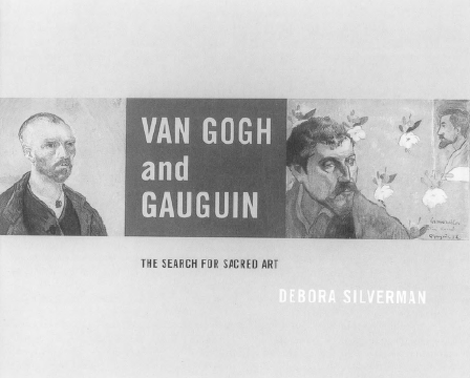 fig. 1
Cover of Debora Silverman, Van Gogh and Gauguin: the search for sacred art | |
[pagina 11]
| |
Keynote address: current research on Van Gogh and Gauguin
| |
[pagina 12]
| |
project on Gauguin; Walter Feilchenfeldt's work on Van Gogh provenance; and the exemplary catalogues of Van Gogh's paintings and drawings produced by Sjraar van Heugten, Louis van Tilborgh, and Marije Vellekoop of the Van Gogh Museum.Ga naar voetnoot6 Our understanding of each artist has been enriched by a number of recent exhibitions. These include the Gauguin and Van Gogh shows curated by Ronald Pickvance for Martigny; the investigation by Anne Distel, Susan Stein, and Andreas Blühm into Dr Gachet's role as a collector, seen in Paris, Amsterdam and New York; and the Boston-Philadelphia-Detroit study of Van Gogh's portraits, with essays by Dorn, George Shackelford, Joseph Rishel and others.Ga naar voetnoot7 2001 saw the Wadsworth Atheneum's exhibition treating Gauguin and the School of Pont-Aven, with contributions by Merlhès, Welsh-Ovcharov and the late Robert Welsh. Notable as well was The Saint Louis Art Museum's Vincent van Gogh and the painters of the Petit Boulevard, organised by Cornelia Homburg with essays by John House, Liz Childs and Richard Thomson.Ga naar voetnoot8 Both exhibitions carried forward important earlier explorations of the contacts and exchanges between each of the two painters and the young artists of their circle. At the same time, the Gauguin literature was enriched by notable monographs, including Vojtĕch Jirat-Wasiutyński and Travers Newton's Technique and meaning in the paintings of Paul Gauguin, a groundbreaking study linking art history and conservation science, and Nancy Mowll Mathews's biography Paul Gauguin: an erotic life, which considers the shaping role of sexuality and aggression in his relationships and his art.Ga naar voetnoot9 At the same time, several books specifically about the Van Gogh-Gauguin relationship have appeared, beginning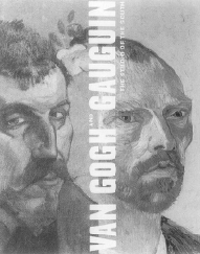 fig. 2
Cover of Douglas W. Druick and Peter Kort Zegers, Van Gogh and Gauguin: the Studio of the South with Naomi Maurer's The pursuit of spiritual wisdom, relating the artists' conceptions of spirituality to symbolist currents and imagery.Ga naar voetnoot10 Debora Silverman took a very different approach in her award-winning Van Gogh and Gauguin: the search for sacred art (fig. 1), a closely argued study of the impact on their relationship of their divergent religious legacies and educational formations.Ga naar voetnoot11 Reclaiming and characterising Van Gogh's protestant Dutchness and | |
[pagina 13]
| |
Gauguin's French Catholic heritage, Silverman aims to ‘bring religion back into the story’ of the artists' consciousness. This approach focuses more on differences than on dialogue, for she sees ‘Van Gogh's and Gauguin's worldviews and artistic practices’ as ‘incommensurate.’ The psychoanalytic lens replaces that of religion in Bradley Collins's still more recent book subtitled Electric arguments and utopian dreams, in which the author's expressed aim is to ‘introduce nuance and complexity into the polarised conception’ of the artists as diametrical opposites - to nuance received ideas about Van Gogh's and Gauguin's personalities.Ga naar voetnoot12 Van Gogh and Gauguin: the Studio of the South (fig. 2) now takes its place alongside these parallel projects.Ga naar voetnoot13 Because all were essentially conceived, written and published concurrently, the various authors were largely unable to take the many new ideas under consideration. Similar dust-jacket designs (figs. 1 and 2) are only partially explained by marketing priorities; the subject itself dictates some obvious choices. But clearly we cannot judge these books by their covers. Each has posed different questions from different perspectives using a variety of source material. Different approaches have, in turn, yielded different answers, generating the question: to what degree are these answers compatible? In other words, are they irreconcilable? Or do they overlap and complement each other in ways that illuminate different facets of a complex relationship? Ongoing interrogation keeps the discipline alive, as shown by the papers presented at this symposium. In my remarks, I will not presume to draw conclusions. Instead, I will sketch out how we at The Art Institute came to pose the questions we did in conceiving our project, outline the resources we deployed in testing our ideas and offer some thoughts about ways in which the answers we generated play with and against those offered by others.
Peter Zegers and I initially became interested in the Van Gogh-Gauguin relationship through our work on Gauguin following on the 1988 retrospective exhibition Chicago co-organised with Washington and Paris.Ga naar voetnoot14 Specifically, we reconsidered Gauguin's response to the 1889 Exposition Universelle. Three years prior to this landmark world's fair, in 1886, the artist had rejected the idea of a job in colonial Tahiti, considering this isolation to be essentially inimical to his ambitions as painter. But by the time of the Exposition, he was actively constructing a project to pioneer a new art in the French colonies and described this project (for example in a letter to Van Gogh) as a ‘Studio of the Tropics,’ with himself in the annunciatory role of a John the Baptist for the art of the future. Such heroic posturing has of course been aligned with symbolism, to which Gauguin would by 1890 be a recognised contributor. But this begs the question of how Gauguin imaginatively transformed Tahiti from a colonial backwater into a creative destination. Certainly factors such as his 1887 trip to Martinique, the colonial exhibitions of 1889 and the interests of friends like Schuffenecker and De Haan played into this. But we perceived clear signs suggesting that it was his relationship with Van Gogh and the discussions in Arles that had been catalytic in fostering Gauguin's nascent mythicising ambitions. It seemed that just as Gauguin began to represent Breton peasants through the lens of Cambodian stylisations - as in the Jeanne d'Arc decoration for the inn of Marie Henry (private collection), which incorporates a gesture from Cambodian sculpture - so he embroidered his ambitions with the mythic language and concepts fostered | |
[pagina 14]
| |
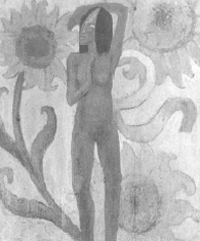 fig. 3
Paul Gauguin, Female nude with flowers (Caribbean woman), 1889, private collection by his dialogue with Van Gogh. The Dutch artist appears symbolically in another decoration of Gauguin's known as the Caribbean woman (fig. 3): the sunflowers, emblematic of Van Gogh, are a theme that he had introduced into their exchanges in Paris and in Arles; the dark-skinned woman alludes to Gauguin's Martinique figure paintings, chief among them Among the mangoes (Amsterdam, Van Gogh Museum), which for both Van Gogh brothers were a benchmark in contemporary art. The panel effectively advertises the concept that Van Gogh actually outlined when he wrote to his sister in early 1888 that a modern painter should ‘do something like what one finds in Pierre Loti's book Le mariage de Loti, in which the nature of Tahiti is described’ [593/W3]. This was the concept that while together in Arles, with Van Gogh taking the lead, he and Gauguin transformed into the Studio of the Tropics. A reciprocal formative dynamic - the importance of Gauguin for Van Gogh - was suggested by Van Gogh's letters and paintings: his meeting with Gauguin and the unfolding of their relationship seemed to us critical to his imaginative transformation of the modest yellow house he rented in Arles into a destination: the embodiment of the ‘Studio of the South,’ the missionary headquarters he dreamed of for a brotherhood of painters who would share his belief in art as a source of consolation amidst the challenges of modern life. Gauguin seemed to be a catalyst for the works Van Gogh painted during the summer of 1888 in anticipation of his arrival in Arles, including the famous Sunflowers (F 456 JH 1561; F454 JH 1562) and Starry night over the Rhône (F 474 JH 1592). After Gauguin's departure. Van Gogh continued their dialogue, though he notably employed altered formal means, as in the second Starry night (F 612 JH 1731) wherein he attempted a kind of artistic communion with the colleague he hoped one day to rejoin, by consciously working out their discussions around the issue of ‘style.’ The pairing in Chicago of these two profoundly different pictures of the star-filled sky, one painted before and the other after the nine weeks together in Arles, suggests the profound impact of the experience. Similarly, Gauguin's repetition, near the end of his life, of the motifs from his 1889 panel in his sunflower still lifes speaks to the way the Studio of the South exerted an imaginative hold on his Tahitian project. In short, it appeared to us that Van Gogh and Gauguin helped each other to shape their respective artistic identities - and ultimately their work - in ways that distinguish their relationship with each other from the relationships they had with other contemporaries.
Initiating the Amsterdam-Chicago collaboration in 1997, we approached Van Gogh and Gauguin as two profoundly different - and differently formed - artists, who though seemingly predetermined by worldview and temperament to misunderstand each other, nonetheless played off these differences in a process of establishing their own identities. In this enterprise, the nine weeks the two painters spent living and working together in Arles are critical. This concentrated period offered a unique opportunity to both consider cultural construction and attempt to grasp the actuality of creativity in terms of lived experience. I will now describe a few of the tasks we set ourselves in this effort. Benefiting from the rich existing literature on the artistic production in Arles, we nonetheless had to confront the blanks that remained at the material core of the painters' shared history. Surprisingly, there has been no | |
[pagina 15]
| |
consensus on precisely what Van Gogh and Gauguin painted while together and in what order. This has quite naturally impeded an understanding of how their relationship unfolded: what were the issues, when did they come into play, how were they played out in pictures? For each time the two artists set up their easels to work side by side constitutes one event in a series of such events. Depending on how these events are ordered, the picture of their evolving collaboration changes. To address this, we undertook a technical investigation in the hope that new patterns of making, and ultimately meaning, would emerge. A team of conservators from both institutions - Cornelia Peres, Kristin Lister, Inge Fiedler and Ella Hendriks - embarked on a three-year project to examine pictures around the world, armed with insights yielded by recent investigations by other scholars and restorers.Ga naar voetnoot15 They employed a variety of means, including microscopic study, x-radiography, thread counts, fibre and paint-sample analysis. Of particular interest were the experimental pictures both men painted on the 20 metres of coarse jute they purchased shortly after Gauguin's arrival. Comparison of thread counts established the specific characteristics - the ‘fingerprint,’ as it were - that distinguishes the Arles jute from similar material employed at other times. In addition, it emerged that Van Gogh and Gauguin experimentally applied a series of three different ground preparations to the jute. These findings, along with analysis of their give-and-take in the use of other materials and compositional strategies, enabled us to more securely establish both the parameters and the chronology of their production together and served as one basis for inferring the dialogue. The pattern of exchange between the two suggested a kind of syncopated creative dynamic: while at moments Van Gogh and Gauguin clearly resisted one another, at other times each took on the other's ideas in canvases which, compared to their previous paintings, are markedly - sometimes disconcertingly - experimental. One case in point is the Memory of the garden (fig. 4), the picture Van Gogh painted in response to Gauguin's ideas about working from the imagination. Based in part on the grounds and also upon the inferred exchange of ideas, we concluded that Van Gogh borrowed Gauguin's ideas about painting, but at the same time provided a composition to Gauguin, whose closely related Arlésiennes (Mistral) (fig. 5), painted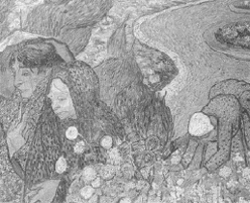 fig. 4
Vincent van Gogh, Memory of the garden (F 496 JH 1630), 1888, St Petersburg, State Hermitage Museum 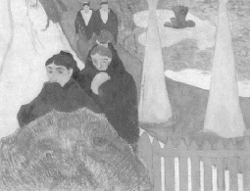 fig 5
Paul Gauguin, Arlésiennes (Mistral), 1888, Chicago, The Art Institute of Chicago, Mr and Mrs Lewis Larned Coborn Memorial Collection | |
[pagina 16]
| |
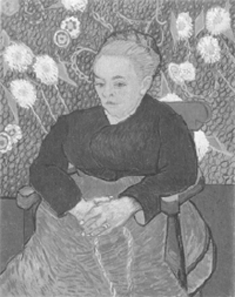 fig. 6
Vincent van Gogh, La berceuse (F 508 JH 1671), 1888-89, Boston, Museum of Fine Arts, bequest of John T. Spaulding weeks later, acknowledged and refashioned (and so implicitly critiqued) a work that Van Gogh saw as a failure. Other key pictures can also be seen in a new light, notably the version of the Sunflowers that Van Gogh painted on what has been confirmed as the ‘Arles jute,’ now datable to the moment in early December when Gauguin was executing Van Gogh's portrait. The Seji Togo Memorial Sompo Museum of Art's Sunflowers (F 457 JH 1666) now find a technical, historical and stylistic context, the lack of which has heretofore occasioned considerable speculation. Indeed the creative give-and-take between Van Gogh and Gauguin suggestively bears out the dynamic model that Pollock originated as the new ‘game plan’ of late-1880s vanguardism: reference, deference and difference - or in this case resistance. Technical findings add another dimension to this scenario, revealing how Van Gogh negotiated Gauguin's exhortations to free himself from the constraints of painting from nature and instead compose ‘de tête,’ or from the imagination and memory. The Novel reader (F 497 JH 1632) was Van Gogh's first major attempt to do so. But it now emerges that the picture he began and indeed largely finished a month later, La berceuse (fig. 6), was shaped by a similar intention: both, in Van Gogh's parlance, were ‘abstractions’ painted from the imagination. Yet the two canvases are nonetheless remarkably different in appearance. The Novel reader is notably strange in the context of Van Gogh's oeuvre. With its abbreviated, caricatural drawing, the large canvas has the appearance of a quick, small sketch that has been greatly magnified. It speaks to Van Gogh's uneasiness in untethering himself from direct experience. But by the time, only weeks later, he embarked on La berceuse, he had discovered a way to reconcile his desire to respond to Gauguin's ideas with his own artistic preferences. As Kristin Lister outlines, Van Gogh employed tracing as a means of moving from the study - rooted in experience - to the ‘tableau,’ the fully realised pictorial statement produced in the absence of a model or motif. The origins of La berceuse lie in the retrenchment of late November. Displeased with works painted ‘de tête’ like the Novel reader or Memory and the garden, Van Gogh returned to a more comfortable enterprise: portraiture from the model. Madame Roulin came to sit, and Gauguin joined Van Gogh in painting her. And, as in earlier joint sessions, the carefully elaborated surface and aura of calm seen in Gauguin's painting (fig. 7) represented a critique of Van Gogh's rapid, gestural, insistently material execution (fig. 8). But Van Gogh evidently hoped to develop the small-scale study into a more ambitious tableau of the kind Gauguin might approve. To this end, as Kristin Lister argues in her article in the last Van Gogh Museum Journal, Van Gogh made tracings of the Winterthur picture which, together with traced elements from other pictures, he used to develop - in the sitter's absence - the portrait of her he entitled La berceuse.Ga naar voetnoot16 The significance of this pictorial grafting is considerable in understanding Van | |
[pagina 17]
| |
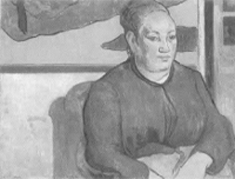 fig. 7
Paul Gauguin, Madame Roulin, 1888, The Saint Louis Art Museum, funds given by Mrs Mark C. Steinberg Gogh's work, for portraiture was central to his view of his own practice. La berceuse was an amalgam, a picture not painted from life, as has traditionally been assumed, but constructed using various pre-existing elements. And this marks a greater departure from basic principles on Van Gogh's part - a greater responsiveness to Gauguin's ideas - than has previously been imagined. Van Gogh used tracings not merely to generate another copy but to move from a life study to a more synthetic tableau, to free himself from the distractions of the model and to accompany Gauguin in the exploration of ‘style.’ Planes of flat colour, strong outlines, and simplified forms and modelling make this a notable attempt at pictorial synthesis, shaped in concert with Gauguin and responsive to the latter's portrait. Painted at a point when the future of their relationship was clearly in doubt, the deference to Gauguin's aesthetic principles in La berceuse would help explain why the picture became so connected with Gauguin in Van Gogh's mind. But the Arles interaction alone did not fully explain the profound connection of La berceuse to Gauguin and their partnership. What led Van Gogh to fetishise the image to the extent of making one version after another, to produce an eventual five versions? Why, a year later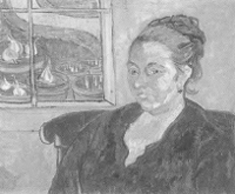 fig. 8
Vincent van Gogh, Madame Roulin (F 503 JH 1646), 1888, Winterthur, Oskar Reinhart Collection when he became disillusioned with the direction Gauguin's work was taking, would Van Gogh specifically renounce the ‘abstraction’ he had been misled to practice in the work? We first went to the often-quoted contemporary letters, in which Van Gogh likened the image to the cheap colour prints of the Virgin that offered comfort to sailors during storms at sea. But far from an explanation, this curious comparison only demanded further excavation of the works themselves and of the written texts. The letters, as has long been recognised, are not transparent documents. Marshalling them as ‘evidence’ is problematic. For example, as Dorn and others have noted, Van Gogh consistently ‘rationalised his activities as purely logical,’ both to reassure himself and to persuade his correspondents. Self-deceptions thus assume the guise of straightforward fact. In Gauguin's writings, posturing and bragging sometimes operate similarly. And the large body of his retrospective writings is further cloaked by time, distance and changing priorities. But there are other, perhaps less obvious pitfalls to this body of materials. In Van Gogh's case, the sheer number of letters gives them an authority that can be blinding. So much is mentioned - about paintings, books, feelings - that there is a natural tendency to rule out what | |
[pagina 18]
| |
does not appear. This, in effect, applies interpretive limitations to Van Gogh that exist for virtually no other artist. For example, Liz Childs's recent discussion of Van Gogh's self-mutilation in the context of practices of the Japanese brothel may potentially meet with resistance precisely owing to the lack of a direct letter reference, despite the presentation of other evidence.Ga naar voetnoot17 The letters also pose problems for a consideration of Van Gogh's formative years, before age 19, when his correspondence - as published - began. Our effort to recuperate Van Gogh's worldview involves acknowledging the metaphoric thinking central to the tradition of emblems so prevalent in his cultural heritage. This emblematic thinking is referenced only by implication in his later writings and reminiscences of his youth. Similarly implicit is the legacy of reformist Dutch theologian Allard Pierson, whose ‘anti-supernaturalist’ Protestantism figures centrally in Silverman's construction of the religious outlook that informed Van Gogh's art. It is not to be expected that the influences that shaped his youth should necessarily find direct echo in his later writings. An omission of a different order has, in our view, thwarted a nuanced understanding of the Van Gogh-Gauguin relationship: while many letters survive, a significant number have been lost. This includes most of Theo's letters and, as we know from Merhlès's work, the bulk of the correspondence between the principals. Only six of some 30 letters from Van Gogh to Gauguin survive, and at least nine (of 25) letters from Gauguin are lost. As a result, Van Gogh's relationship with the young Emile Bernard has entered history as more vivid - in a sense more ‘real’ - since it is articulated in the 22 surviving letters Van Gogh wrote him in 1888-89. This is potentially deceptive, turning attention away from the actual collaborative experience of Van Gogh and Gauguin and instead fostering the assumption that their relationship acquires significance only insofar as it sheds light on the independent roles each played in art history as subsequently written. Without doubt the friendships that both artists enjoyed with Bernard were very significant, as Dorn, Jirat-Wasiutyński and others have argued. But while at certain junctures Van Gogh entertained inviting Bernard as well as others to join the Studio of the South, the extant correspondence leaves little doubt that from the very first, and to the very end, it was Gauguin's participation that Van Gogh fixed his hopes on; it was Gauguin he idealised and, in his letter thanking critic Albert Aurier for his attention, publicly deferred to. Bernard was a younger friend whom Van Gogh truly admired; Gauguin, his senior, he hero-worshiped. And to one whose idea of heroism came straight from Thomas Carlyle, this was a crucial distinction. The nuances in this triangulated relationship are suggested in the self-portrait exchange of October 1888. Trading portraits. Van Gogh and Gauguin each assumed a dramatic persona: Van Gogh as an austere Japanese bonze, Gauguin as the outcast protagonist Jean Valjean from Hugo's Les misérables - one of the books, in fact, that Van Gogh virtually required his close friends to admire as he did. Gauguin had just finished reading it. Bernard, by contrast, did not participate in this mutual posturing: the dedicated self-portrait he sent to Van Gogh notably avoids heroics, conveying its sincerity through its childlike simplicity, as Jirat-Wasiutyński has observed. Bernard's painting was perhaps more pleasing to Van Gogh, but Gauguin's offered a number of challenges that accelerated Van Gogh's resolve to bring him to Arles without further delay. To understand the nature and substance of the attraction and dialogue between Van Gogh and Gauguin, we undertook a cross-grained reading of the extant written texts by both artists. Our aim was to understand the different histories each artist brought to their relationship and the ways in which these essential differences - guarantees of misunderstanding - were nonetheless experienced as stimulating and, ultimately, productive. This recuperative exercise informed the extension of our focus to what came before and transpired after Arles. We approached the texts with the dual aims of teasing out the patterns of thinking that could illuminate the mutual interest, and of inferring the dialogue that might have taken place in the lost letters and the Yellow House. We began with sustained, close readings of the entire correspondence in the original Dutch and French, attentive to the repetition and variation of ideas and language and the circumstances in which they occurred. As scholars have noted, such clusters of associations are particularly relevant for understanding how the experiences of art, literature and life filtered Van Gogh's outlook on the world. This protracted exercise established the template for our rough sketch. However, we recognised that to elaborate, in counterpoint with the pictures, we would have to engage with | |
[pagina 19]
| |
the full range of the correspondence. To this end we scanned in all the published texts, ordered according to the most current dating, to create a databank that allowed for searching in and across the bodies of the correspondence of Van Gogh, Gauguin and their families and friends. This allowed us to interrogate intentions and identify recurrent, altered, and new concerns and language. We see this resource, used in conjunction with the pictures and recent technical data, as providing a new sort of context in which to re-view the Van Gogh-Gauguin relationship. In this way, for example, we found that Van Gogh's 1889 characterisation of the failed Studio of the South as a shipwreck carried multiple meanings: long before meeting the ex-sailor Gauguin, Van Gogh persistently used this conventional figure and related maritime metaphors to express professional and personal ambitions, hopes and fears. Thus, early on, he had represented his establishment of a studio in The Hague in terms of launching a boat (he tried to fit it out like a barge; claimed to love it as a sailor his ship; and simultaneously figured it as the long-sought harbour or refuge). In an initial attempt to forge a kind of artistic brotherhood, Van Gogh had invited his contemporary Anton van Rappard to join him in becoming a ‘fisherman on the sea that we call the Ocean of Reality’ [188/R6].Ga naar voetnoot18 Such habitual figuration - continued in his 1889 accusation that Gauguin had abandoned ship when he left Arles - invests Van Gogh's comparison of La berceuse to a sailor's ex-voto with additional significance, illuminating the concerns that had played into its making and presaging what would follow after the painting's execution. Such newly revealed connections allowed for a more nuanced appreciation of the impact on Van Gogh of the first meeting with Gauguin, helping to account for the profound significance of the deep ‘poetry’ he discerned in the Martinique pictures, which suggested to him that their maker might be what he himself hoped to be, an heir to Jean-François Millet. Given his habitual ways of thinking, Van Gogh read the ex-sailor as possibly the ideal companion for the creative voyage into uncharted waters. In turn, Van Gogh's metaphoric reading held immense imaginative appeal for Gauguin, who indeed suggestively incorporated the shipwreck theme in one of the Volpini lithographs executed immediately after returning to Paris from Arles. At the same time, Van Gogh expressed his continued attachment to what Gauguin represented to him in his repetitions of compositions associated with Gauguin - the Sunflowers, La berceuse and the Arlésienne based on the drawing Gauguin left behind in Arles. These extend the relationship beyond the events of December and into the last months of Van Gogh's life. Our focus, broadened well beyond Arles in time and place, reflects our view that the expectations invested in the Van Gogh-Gauguin relationship had their roots in the past and that the experimentation continued into the future. Certainly Theo recognised a parallel ‘search for style’ - synthetic mannerisms of which he disapproved - in the work he received from Van Gogh in Saint-Rémy and Gauguin in Brittany during the summer of 1889. But as the pairing we made in Chicago of Van Gogh's Mountains (F 622 JH 1766) and Gauguin's Flageolet player on the cliff (Indianapolis Museum of Art) suggests, in their parallel pursuits the two artists never produced the kind of interchangeable styles that is notably found in the cubist works of Braque and Picasso around 1911. Instead theirs is a remarkable situation wherein deeply personal forms of art emerged from the idea of a shared enterprise.
Our results have several points of contact with recent scholarship. We shared Debora Silverman's hope, voiced in the introduction to The search for sacred art, that the reader would ‘come away ... with a different view of Van Gogh and Gauguin from the one they began with.’ Are the different views essentially irreconcilable, or in fact complementary? Reading Bradley Collins's new book, for example, we were struck by the number of instances in which we had arrived at similar conclusions despite different emphases and interpretive strategies. Moreover, certain analyses, when considered together, may add up to a newly suggestive synthesis. For example, we did not address the phallic symbolism that Collins (most recently) reads in Van Gogh's two chair portraits (F 498 JH 1635 and F 499 JH 1636). But the contrast he describes between the still-life objects on the two chairs - big/small, erect/flaccid - potentially takes on a more resonant meaning in light of our finding that Van Gogh added the pipe and pouch to the | |
[pagina 20]
| |
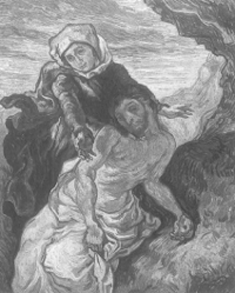 fig. 9
Vincent van Gogh, Pietà (after Eugene Delacroix) (F 630 JH 1775), 1889, Amsterdam, Van Gogh Museum (Vincent van Gogh Foundation) seat of his own chair only after Gauguin had left - when he would certainly have been experiencing feelings of loss and powerlessness. In other words, considering the image through the perspective of time inflects the intention suggested by a psychoanalytic reading. We have investigated familiar paintings and writings with a view to eliciting new sources and contexts in which to consider the relationship. Using some of the same sources and bringing other new ones to bear, Silverman has arrived at a very different view of the relationship, stressing the inevitable incompatibilities between the two, the result of their disparate formations, specifically the different theological cultures that produced them, and that they carried over, metaphorically and materially, into their canvases. Are the accounts presented in The search for sacred art and Van Gogh and Gauguin: the Studio of the South compatible? From our point of view, yes - but inevitably not congruent. Silverman's interrogation starkly illuminates the day-and-night differences to which the two ‘chair portraits’ indeed allude. But we would argue that these culturally determined polarities were in each case significantly modified by individual temperaments and varied life experience. Thanks to Silverman's work, we must henceforth associate Gauguin's ‘mental habits and attitudes toward the visual’ with the three years he spent at the Orléans Catholic Junior seminary, where the religious education adhered to the principles of educational reformer Bishop Dupanloup. This seminary experience, however, was only one piece of the geographical, cultural and social patchwork quilt that was Gauguin's early formation: in Spanish Lima as well as Orléans and Paris, in different socio-economic circumstances, and at four different schools between the ages of six and 17, when he joined the merchant marine. The product, in short, of diverse educational and cultural experiences, Gauguin was accused by Pissarro of being a ‘bricoleur,’ one who took things here and there as he found them. A more positive characterisation would describe him as flexible, responsive, open to new ideas, adaptable and - to extend the point -predisposed to the sense of irony that comes with always being an outsider. As for Van Gogh's formation, we subscribe to Silverman's persuasive marshalling of the specific ingredients of his ‘Dutchness,’ with its dominant strains of anti-individualism and anti-supernaturalism that located divinity in tangible reality. Certainly this fed into his self-image and his art. But we also see these characteristics tempered by what Collins has termed a polarisation, a sense of alienation from the northern culture of his father that led him to seek a more authentic ‘homeland,’ first in art and then in the Studio of the South. To be sure. Van Gogh's mature outlook on life, religion and art has much in common with that of Dutch religious reformists like Pierson. But just as clearly. Van Gogh arrived at this position circuitously: after a protracted and idiosyncratic quest, in which he let himself be guided (and his essential ‘Dutchness’ inflected) by authors who led him far afield: Renan, Michelet and - from early on and extensively we argue - the Scottish philosopher Thomas Carlyle, and finally Wagner. In this way. Van Gogh forged an independent identity that accommodated the characterological differences | |
[pagina 21]
| |
 fig. 10
Paul Gauguin, Christ in the garden of olives, 1889, West Palm Beach, Florida, Norton Museum of Art of which he and his family were acutely aware. This in turn both permitted and problematised the conversation with Gauguin. A case in point is the discussion, played out after Arles, in which they cast their ambitions for painting in terms of the artist as spiritual leader, as John the Baptist or even Christ. As others have recognised, Van Gogh shared Gauguin's propensity to grandiosity, nurturing a longstanding, powerful identification with Christ, more specifically the suffering Christ in Gethsemane. This ‘exalted side of Van Gogh's polarised self-image,’ as Collins terms it, contradicted the core teachings of his youth and his own repeatedly avowed attachment to the ‘possible, logical and true.’ Other incidents make the same point, for example his identification, on the one hand, with humble craftspeople like weavers; and, on the other, his rationalisation of his belated start as he approached his 30th birthday with the recollection that Jesus had been an ordinary carpenter until roughly the same age. Van Gogh could not readily shed ambition of this sort, and he frequently expressed uneasiness. Having attempted and failed to realise two Gethsemane paintings prior to Gauguin's arrival, Van Gogh's behaviour leading up to the explosive episode of 23 December involved acting out his identification with Christ, as Gauguin reported immediately afterward. In the Pietà painted in Saint-Rémy (fig. 9), Van Gogh sidled up to this identification in a way that expresses his ambivalence, avoiding the dangerous temptation of ‘abstraction’ by working after a composition by Delacroix, but suggesting his own features in the face of Christ. Gauguin, by contrast, felt no such culturally inculcated qualms in externalising the fantasies of mythic heroism that he and Van Gogh discussed in Arles, as is amply demonstrated by his self-portrait as Christ in the garden of olives (fig. 10). If at one level the picture, as Silverman proposes, speaks to Gauguin's fluency with a dialectic of | |
[pagina 22]
| |
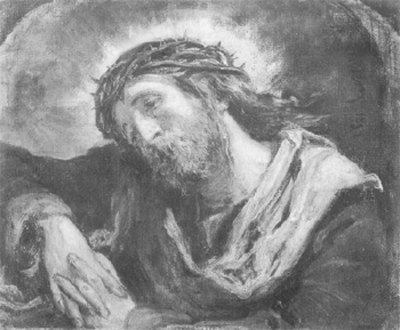 fig. 11
Antoine Verdier, Christ with a crown of thorns: portrait of Alfred Bruyas, 1852, Montpellier, Musée Fabre inwardness and otherworldliness propounded at the seminary, on another level, the red hair signals Van Gogh and thus continues the Arles discussions about artistic identification and brotherhood. It is not simply the physical attribute of red hair that is significant, but rather how it had become coded in their discussions as a signifier of a brotherhood of outcasts. Van Gogh's imagination had first been captured by the idea of a brotherhood of redheads years earlier, when he was trying to recruit Theo to abandon his job and join him in forming a literal brotherhood of painters. The concept had resurfaced in December 1888, when - the partnership with Gauguin now very much in doubt - the two together visited the museum in Montpellier. There, in Delacroix's portrait of the redheaded Alfred Bruyas, Van Gogh discerned a new brother in suffering, a martyr to the loss of a similar ideal - a Studio of the South. In commissioning a portrait of himself as Christ crowned with thorns (fig. 11), Bruyas enacted Van Gogh's own identification. Gauguin's Christ, whose gesture echoes that made by Bruyas in another portrait, by Delacroix (1853; Montpellier, Musée Fabre), angered Van Gogh not so much because it offended his avowed commitment to ‘the true,’ but because it touched on their competitiveness and | |
[pagina 23]
| |
on the grandiosity that, as Collins observes, Van Gogh disavowed through anger. It was at this moment he also renounced the ‘abstraction’ he now saw in La berceuse. All of these examples point to the reasons we privilege the Gauguin-Van Gogh relationship in our study, singling it out from other alliances that each formed with other members of the Parisian vanguard.
As part of the larger art-historical enterprise, recent scholarship on both Gauguin and Van Gogh has worked to recover them from the processes of modernist mythmaking that have turned each into a fabricated, heroic persona, as Pollock has acutely analysed. The anti-mythical drive gives social depth and historical meaning to art by placing it in dialogue with a lived and experienced social world. But it should not obscure an important consideration: Van Gogh could readily be assimilated to a major trope of western culture, the sacrifice of Jesus, and by extension could be presented in art-historical narrative as modern artist/secular Christ precisely because he scripted the lineaments of the identity himself, in a process that began long before he arrived in Paris. The counter-mythic impetus ‘normalises’ Van Gogh by situating him in the larger creative context of the young French vanguard. And we agree with Homburg and others that the exchange of ideas and a sense of group identity with his Parisian contemporaries contributed to Van Gogh's construction of his artistic identity. But to conclude that ‘his ambitions were not very different from those of his contemporaries’ overdetermines the contextual argument. For there is every indication that Van Gogh's ambitions were profoundly different - shaped by different sources and differently formed. Van Gogh was not just speaking metaphorically when he stated that art was a faith. He believed that painting could be a new gospel for the modern age. His conception of the artist, seeded by Dutch theological culture, was finally shaped by Carlyle's concept of the Hero - the genius who is able to cast eternal truths in new forms responsive to the needs of his age - and extended to encompass a confraternity including artists and prophets, with Christ at its head. Such was the exalted ambition that Van Gogh brought with him to Paris, and that he intuited in Gauguin's work and person. In turn Gauguin, in the climate of nascent symbolist ideas and given his own needs, found it suggestive to be cast by Van Gogh as ‘The Wanderer,’ or as Gauguin himself quoted, ‘the man from afar who will go far.’ Although it is important to dismantle mythic narratives and interrogate their formation, the shaping force of such narratives in the Van Gogh-Gauguin relationship should be acknowledged. In conclusion, we believe that different views of the Van Gogh-Gauguin relationship can in a sense be superimposed, seen through each other to produce a more complex, three-dimensional picture of the ways in which individual and idiosyncratic particulars inflect broader artistic and cultural shaping forces, and vice-versa. We do not propose a heroic narrative, but rather a consideration that addresses heroics in the construction of identity. Our enterprise has involved studying Van Gogh and Gauguin as the context for each other's art and artistic personae, with the aim of charting the interplay of ideas - ideas that clearly extend far beyond the two who articulated them, and that indeed continue to intrigue scholars more than a century later. |
|

